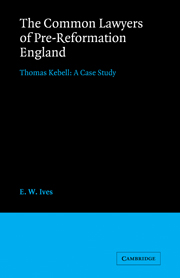Book contents
- Frontmatter
- Contents
- List of figures and tables
- Preface
- Abbreviations
- Manuscript sources
- Table of cases
- Introduction
- PART I THE LEGAL PROFESSION
- PART II LEGAL PRACTICE
- PART III THE LAWYERS AND THE LAW
- PART IV THE PROFESSION AND SOCIETY
- 13 The rewards of the profession: fees and payments
- 14 The rewards of the profession: income and morality
- 15 The rewards of the profession: the estates of Thomas Kebell
- 16 The rewards of the profession: Humberstone Manor
- 17 Social mobility: the Kebells of Humberstone
- 18 Thomas Kebell and the pre-Reformation legal profession
- Retrospect
- Appendices
- Index
16 - The rewards of the profession: Humberstone Manor
Published online by Cambridge University Press: 05 November 2011
- Frontmatter
- Contents
- List of figures and tables
- Preface
- Abbreviations
- Manuscript sources
- Table of cases
- Introduction
- PART I THE LEGAL PROFESSION
- PART II LEGAL PRACTICE
- PART III THE LAWYERS AND THE LAW
- PART IV THE PROFESSION AND SOCIETY
- 13 The rewards of the profession: fees and payments
- 14 The rewards of the profession: income and morality
- 15 The rewards of the profession: the estates of Thomas Kebell
- 16 The rewards of the profession: Humberstone Manor
- 17 Social mobility: the Kebells of Humberstone
- 18 Thomas Kebell and the pre-Reformation legal profession
- Retrospect
- Appendices
- Index
Summary
On Monday, 6 July 1500, ten days after Kebell's death, the official party came to Humberstone to schedule his goods for probate. Whether or not they were actually led by Valentine Mason, general appraiser for the Canterbury archdiocese (and Kebell had been wealthy enough to attract such attention), the resulting inventory was drawn up with care. The inspection followed the lay-out of the building, room by room, and this is fortunate, for otherwise nothing would be known about the house which Kebell occupied. Not only does it no longer exist, but even the site is forgotten. The two manors of Humberstone village each had their great house, Hotoft's where Kebell lived, and Haselrigge's where the family of that name still lived, but more than this cannot be said. One of the sites is now occupied by a hospital, during the building of which medieval foundations were discovered, but there is nothing to indicate which house this was, and memory of a second site has vanished. But thanks to the inventory, drawn up on that first Monday of July in the year 1500, at least a good guess can be made of what the Kebell home was like.
The house which the appraisers came to visit was a two-storey building, with a central hall and one protruding wing, a type very common at the time. It was probably an old building–there is no evidence of recent work on the main structure of the house–and it was perhaps much as his ‘kind cousin’ Richard Hotoft had known it forty years before.
- Type
- Chapter
- Information
- The Common Lawyers of Pre-Reformation EnglandThomas Kebell: A Case Study, pp. 354 - 367Publisher: Cambridge University PressPrint publication year: 1983



